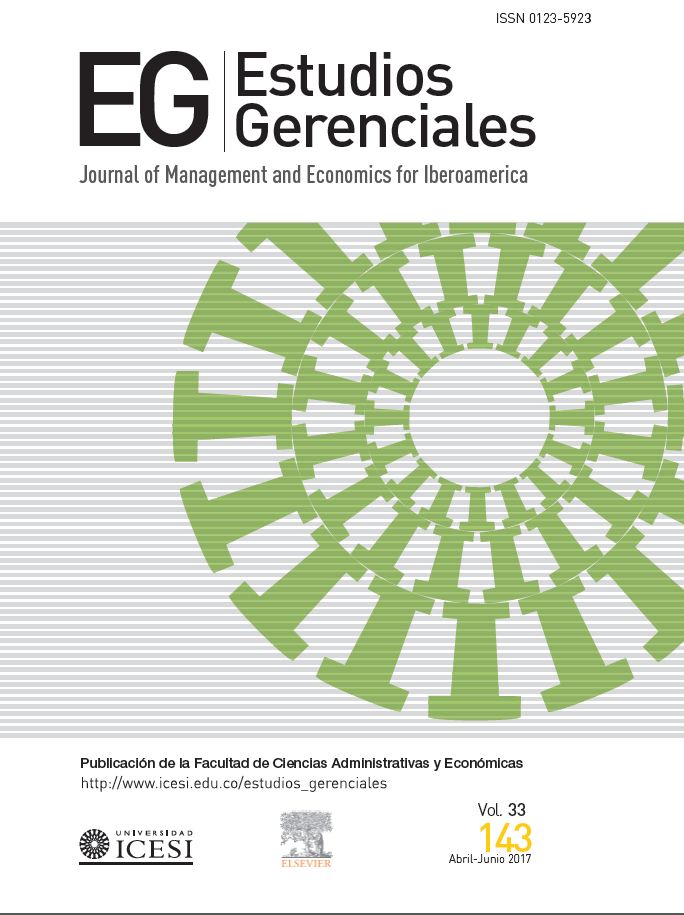Metodología de distribución de plantas en ambientes de agrupación celular
DOI:
https://doi.org/10.1016/j.estger.2017.03.003Palabras clave:
Distribución de plantas, Tecnología de grupos, Manufactura flexibleResumen
Este artículo propone una metodología para la distribución de plantas en sistemas de manufactura flexible, basada en métodos cuantitativos para agrupación de familias, formación de células de manufactura y el uso de técnicas multicriterio. Respecto a la agrupación de productos, se consideraron criterios geométricos y se usó un modelo p-mediana modificado para la creación de células. De esta forma, la distribución de planta apropiada se escogió utilizando el proceso analítico jerárquico, evaluando diferentes alter-nativas obtenidas con el modelo Quadratic Assignment Problem, que considera el número deseado de células a formar y los coeficientes de similitud empleados para la agrupación celular. La metodología propuesta se probó a través de un caso real, verificándose la conveniencia del procedimiento en una empresa colombiana del sector metalmecánico.
Descargas
Referencias
Cela, E. (2013). The Quadratic Assignment Problem: Theory and Algorithms. New York: Springer Science & Business Media.
Chiang, W. C., Kouvelis, P. y Urban, T. L. (2006). Single- and multi-objective facility layout with workflow interference considerations. European Journal of Operational Research, 174(3), 1414–1426. http://dx.doi.org/10.1016/j.ejor.2005.03.007
Davis-Sramek, B., Mentzer, J. T. y Stank, T. P. (2008). Creating consumer durable retailer customer loyalty through order fulfillment service operations. Journal of Operations Management, 26, 781–797.
Dixit, A. R. y Gupta, M. (2013). Current status, enablers and barriers of implementing cellular manufacturing system in Indian industries. Advances in Manufacturing, 1(4), 346–356.
Drira, A., Pierreval, H. y Hajri-Gabouj, S. (2007). Facility layout problems: A survey. Annual Reviews in Control, 31(2), 255–267.
Hadi-Vencheh, A. y Mohamadghasemi, A. (2013). An integrated AHP-NLP methodology for facility layout design. Journal of Manufacturing Systems, 32(1), 40–45.
Hosseini, S. S. y Seifbarghy, M. (2016). A novel meta-heuristic algorithm for multiobjective dynamic facility layout problem. RAIRO-Operations Research, 50(4-5), 869–890. http://dx.doi.org/10.1051/ro/2016057
Karande, P. y Chakraborty, S. (2014). A facility layout selection model using MACBETH method. Bali, Indonesia: Proceedings of the 2014 International Conference on Industrial Engineering and Operations Management (January 7-9).
Koopmans, T. C. y Beckmann, M. (1957). Assignment problems and the location of economic activities. Econometrica: Journal of the Econometric Society, 25(1), 53–76.
Kusiak, A. (1987). The generalized group technology concept. International Journal of Production Research, 25(4), 561–569.
Liggett, R. S. (2000). Automated facilities layout: Past, present and future. Automation in Construction, 9, 197–215.
Mahdavi, I., Teymourian, E., Baher, N. T. y Kayvanfar, V. (2013). An integrated model for solving cell formation and cell layout problem simultaneously considering new situations. Journal of Manufacturing Systems, 32(4), 655–663.
Matai, R. (2015). Solving multi objective facility layout problem by modified simulated annealing. Applied Mathematics and Computation, 261, 302–311. http://dx.doi.org/10.1016/j.amc.2015.03.107
Miltenburg, J. y Zhang, W. (1991). A comparative evaluation of nine well-known algorithms for solving the cell formation problem in group technology. Journal of Operations Management, 10(1), 44–72.
Raman, D., Nagalingam, S. y Chiu, W. (2005). A fuzzy rule based system to measure facility layout flexibility. ICPR-18 Conference Proceedings of the 18th International Conference on Production Research - The Networked Enterprise: A Challenge for a Sustainable Development. pp. 1–5. Italy: University of Salerno.
Raman, D., Nagalingam, S. V. y Lin, G. C. I. (2009). Towards measuring the effectiveness of a facilities layout. Robotics and Computer-Integrated Manufacturing, 25(1), 191–203. http://dx.doi.org/10.1016/j.rcim.2007.06.003
Salazar, A. F., Vargas, L. C., Añasco, C. E. y Orejuela, J. P. (2010). Propuesta de distribución en planta bietapa en ambientes de manufactura flexible mediante el proceso analítico jerárquico. Revista EIA, 7(14), 161–175.
Saraswat, A., Venkatadri, U. y Castillo, I. (2015). A framework for multiobjective facility layout design. Computers & Industrial Engineering, 90, 167–176. http://dx.doi.org/10.1016/j.cie.2015.09.006
Selim, H. M., Askin, R. G. y Vakharia, A. J. (1998). Cell formation in group technology: Review, evaluation and directions for future research. Computers & Industrial Engineering, 34(1), 3–20.
Warrens, M. J. (2008). Similarity Coefficients for Binary Data: Properties of Coefficients, Coefficient Matrices, Multi-Way Metrics and Multivariate Coefficients, Psychometrics and Research Methodology Group, Leiden University Institute for Psychological Research, Faculty of Social Sciences. Leiden University.
Wemmerlov, U. y Johnson, D. J. (1997). Cellular manufacturing at 46 user plants: Implementation experiences and performance improvements. International Journal of Production Research, 35(1), 29–49.
Won, Y. y Lee, K. C. (2004). Modified p-median approach for efficient GT cell formation. Computers & Industrial Engineering, 46(3), 495–510.
Xu, J., Liu, Q. y Lei, X. (2016). A fuzzy multi-objective model and application for the discrete dynamic temporary facilities location planning problem. Journal of Civil Engineering and Management, 22(3), 357–372. http://dx.doi.org/10.3846/13923730.2014 897974
Yang, T. y Hung, C.-C. (2007). Multiple-attribute decision making methods for plant layout design problem. Robotics and Computer-Integrated Manufacturing, 23(1), 126–137. http://dx.doi.org/10.1016/j.rcim.2005.12.002
Yang, T. y Kuo, C. (2003). A hierarchical AHP/DEA methodology for the facilities layout design problem. European Journal of Operational Research, 147(1), 128–136. http://dx.doi.org/10.1016/S0377-2217(02)00251-5
Yang, T. y Hung, C. C. (2007). Multiple-attribute decision making methods for plant layout design problem. Robotics and Computer-Integrated Manufacturing, 23(1), 126–137.
Yin, Y. (2006). Application Similarity Coefficient Method to Cellular Manufacturing. En V. Kordic, A. Lazinica, y M. Merdan (Eds.), Manufacturing the Future, Concepts - Technologies - Visions (pp. 95–258). Alemania: InTech.
Yin, Y. y Yasuda, K. (2006). Similarity coefficient methods applied to the cell formation problem: A taxonomy and review. International Journal of Production Economics, 101(2), 329–352.
Publicado
Número
Sección
Licencia
Los autores de artículos serán responsables de los mismos, y por tal no comprometen los principios o políticas de la Universidad Icesi ni las del Comité Editorial de la revista Estudios Gerenciales. Los autores autorizan y aceptan la cesión de todos los derechos a la revista Estudios Gerenciales, tanto en su publicación impresa como electrónica. Luego de publicado el artículo, puede ser reproducido sin autorización, mencionando autor(es), título, año, volumen, número y rango de páginas de la publicación, y como fuente: Estudios Gerenciales (abstenerse de usar Revista Estudios Gerenciales).








